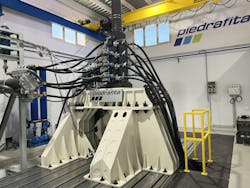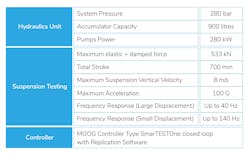R&D Spotlight: Designing a Test Bench for Armored Vehicle Suspensions
Test engineers undoubtedly agree on the need for a test rig that can evaluate the reliability of a vehicle’s suspension system. However, developing and building a high-performance fatigue bench that could be used in the design and specification of armored vehicle suspensions raises the bar on the unique specifications needed for combat scenarios.
Designed for battlefield tasks, these formidable machines are heavyweight and move in terrains with many obstacles at high speed and low visibility. The requirements are highly demanding due to the vehicle characteristics and usage.
Armored vehicles are designed to “make high velocity movements with high forces within the suspension elements, said Luis Barrada, technical director, Piedrafita Systems. “There is a high frequency and low amplitude movement present, caused by the track pitch. It is imperative to have a reliable system that can withstand those hard conditions and deliver the correct suspension characteristics over the lifetime of the system. A fatigue bench or rig that could handle these conditions would be necessary to ensure this.”
Cue the engineers at Moog’s industrial segment who routinely combine electric, hydraulic and hybrid technologies to design and manufacture applications in energy, industrial machinery, simulation and test markets.
Spain-based Piedrafita Systems, which develops rotary suspension solutions for military land platforms, worked closely with Moog engineers to design the Merlin test bench, a high-performance test rig that would be used in designing heavy-duty vehicle suspensions. Piedrafita Systems specified the need for a fatigue test system capable of delivering forces up to 500 kN (80,000 joules per meter) at a speed of 8m/s and up to 200 Hz.
“Piedrafita asked Moog how to make feasible this new system,” said Juan Carlos Molinero, project manager for Simulation & Test at Moog. “After our study and performance tests, we collaborated with Piedrafita to develop a concept that could test an armored vehicle’s suspension.”
The Merlin test bench was unveiled in July 2023, bringing to market a system capable of simulating intense vibrations, and was deemed crucial for assessing shock absorbers and suspension systems in combat scenarios.
Not the First Rodeo for Fatigue Test Bench Design
The parameters may have been unprecedented, but it would not be the first time Moog had worked with Piedrafita on pioneering a novel solution. The companies collaborated in 2013 on the design of a fatigue test bench for developing a shock absorber. Back then, the pair designed a fatigue test bench for military ground vehicles operating in extreme conditions that could deliver up to 80kN at 5 m/s velocity.
This time, however, Piedrafita and Moog’s design and test engineers went above and beyond to deliver a test bench system that not only simulates the movement of an armored vehicle’s tracks over uneven terrain but can reach five times higher forces at twice the velocity and double the frequency range. This level of vibration is crucial for evaluating the resistance and performance of shock absorbers as well as suspension systems in combat scenarios.
The system combines the heavy-duty loading typically found in a high-capacity hydraulic press with the speed and fidelity of a motorsport 4/8-poster rig.
According to the engineers, the test rig is designed to replicate the movement of an armored vehicle over an APG track, as the vibrations experienced during the run are critical in assessing the resistance and related capabilities of the shock absorbers and suspension during combat. The test bench includes a high-performance controller and customized actuators that can reproduce vibration up to 100 G, according to Moog’s chief engineer, Ian Whiting. Nonstandard turbocharged valves were used to achieve the 500kN, 8m/s, 200Hz and 100 G corners of the operating envelope.
READ MORE: Armored Barriers Provide Grid Protection
“Our new test system is capable of carrying out tests for 70-ton tracked vehicles, with a weight of around 5.5 tons per wheel,” added Piedrafita’s Barrada. “Our engineers can test wheel stations under very demanding profiles for main battle tanks such as the Abrams, Challenger, Leclerc and Leopard.”
A Better Design for a Rotary Hydropneumatic Suspension System
The test rig’s delivery is a milestone feeding into a larger project intended to improve heavy armored vehicles mobility, particularly new and legacy main battle tanks.
Piedrafita Systems has been developing a rotary hydropneumatic suspension system for armored vehicles in consortium with Repack-S and IB Fischer CFD+Engineering GmbH. The SRB Project is backed by a grant from the European Defence Industrial Development Programme (EDIDP).
Piedrafita Systems acts as the coordinator on the collaboration and leverages its expertise in designing and validating damping systems. The test bench enhances the company’s proficiency when it comes to standing up to the challenges of designing suspension solutions and improving mobility of heavy armored vehicles and battle tanks.
Optimizing Lifecycle Efficiency
Essential components making up the test system include: a Moog test controller, two hydraulic actuators with Moog digital servo valves, an HPU with Moog digital pumps and a power cabinet, and an accumulator bench with the required piping.
Moog’s Analysis and Simulation Toolbox was also used to demonstrate the likely performance of the proposed twin-actuator servo system. Typical functions of the software include processing customer data, building Simulink models (a MATLAB-based graphical programming environment) and running model cases studies. The simulation software was used to relay the required motions and forces to the test article, according to Moog’s engineers.
In addition to the task of selecting and sizing the test system’s respective components, Moog was tasked with commissioning and training the Piedrafita team on how to operate the system.
“The Merlin test bench is a high dynamic system with high energy accumulated, so it must be operated correctly,” said Federico Gil, lead engineer of Dynamic Testing for Piedrafita Systems. “The software that Moog provides for operating the system (Moog Integrated Test Suite and Replication) are user friendly, even though it is a complex system to operate. This advantage, plus a well-designed training session in the test bench/rig, allowed Piedrafita Operators to learn fast how to operate it and take the most out of all the capabilities the system has to offer.”
Investing in ROI and Reliability
The high-performance test bench minimizes costs and enables tests in a controlled manner. In addition, it waylays the need for driving over a proving ground, “thereby protecting a crew who would otherwise have to be on board a vehicle,” said Barrada.
Proving grounds are generally large terrains used for testing the durability, the weaknesses and probable life of operating equipment under various conditions.
The use of the rig is scalable to other manufacturers in the aerospace and defense segments, too. “Manufacturers such as General Dynamics and KNDS can also test their vehicles’ suspension on our new test system,” said Barrada.
The next phase of this project (SRB2) is well underway. According to a European Defence Fund (EDF) 2023 note, Rotary Suspension for Armoured Vehicles 2 is a follow-on project developing a fully rotary hydropneumatic suspension system for heavy armoured vehicles. The objective is to integrate a toroidal piston as the elastic element and a fully rotary hydraulic damper as the damping element. The new suspension, state the engineers, would improve mobility in heavy armored vehicles, and new and legacy main battle tanks in particular.
About the Author

Rehana Begg
Editor-in-Chief, Machine Design
As Machine Design’s content lead, Rehana Begg is tasked with elevating the voice of the design and multi-disciplinary engineer in the face of digital transformation and engineering innovation. Begg has more than 24 years of editorial experience and has spent the past decade in the trenches of industrial manufacturing, focusing on new technologies, manufacturing innovation and business. Her B2B career has taken her from corporate boardrooms to plant floors and underground mining stopes, covering everything from automation & IIoT, robotics, mechanical design and additive manufacturing to plant operations, maintenance, reliability and continuous improvement. Begg holds an MBA, a Master of Journalism degree, and a BA (Hons.) in Political Science. She is committed to lifelong learning and feeds her passion for innovation in publishing, transparent science and clear communication by attending relevant conferences and seminars/workshops.
Follow Rehana Begg via the following social media handles:
X: @rehanabegg
LinkedIn: @rehanabegg and @MachineDesign




